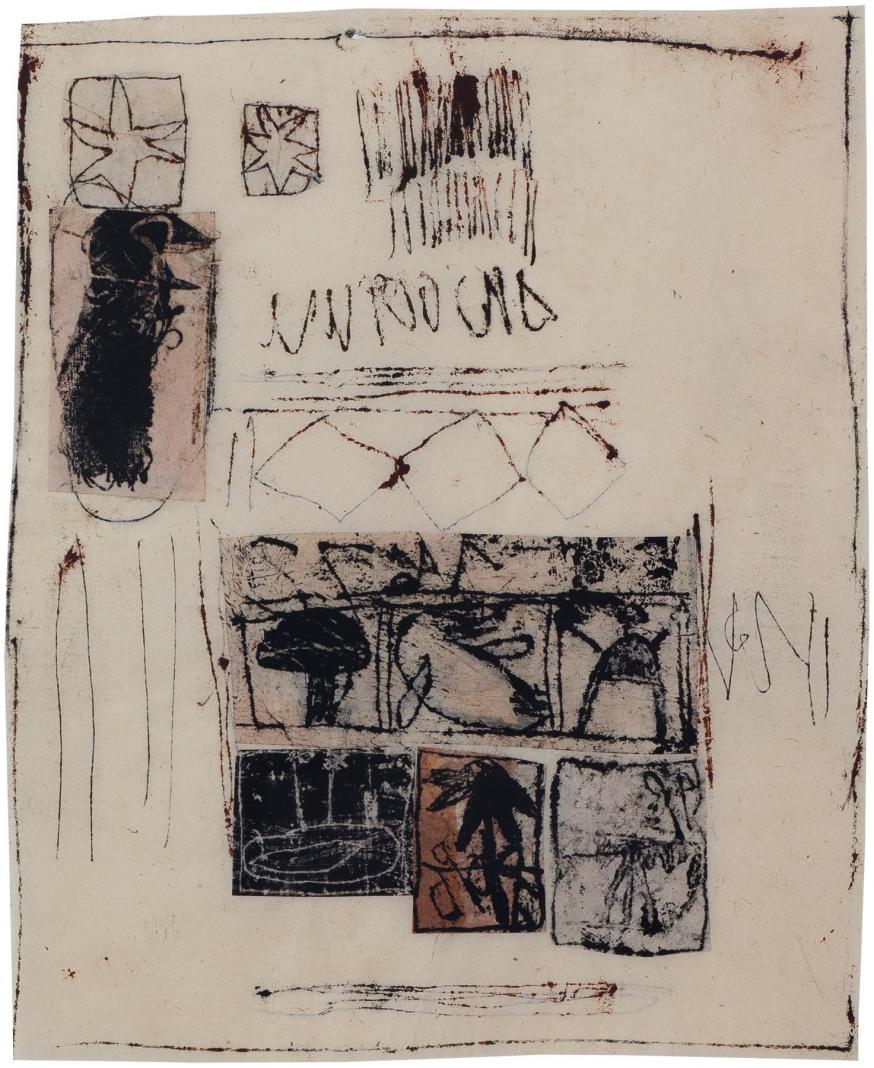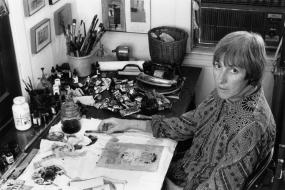Hannelore Baron
1926–1987


Hannelore Baron in her studio, c.1985; Photographer Mark Baron, Courtesy of the Estate of Hannelore Baron
All artworks displayed above are currently available. To inquire about additional works available by this artist, please contact the gallery.
Biography
Everything I’ve done is a statement on the, as they say, human condition…The materials I use in the box constructions and cloth collages are gathered with great care. The reason I use old cloth and boxes is that the new materials lack the sentiment of the old and seem too dry in an emotional sense.
Hannelore Baron (1926–1987) is celebrated for her intimate collages and assemblages that, as Michael Brenson wrote in a 1989 New York Times review, “suggest both the condition of entrapment and the possibility of release.”[1] The compassion, anger, dissent, humor, and silence that animate her work are often rooted in her traumatic experiences as a Jewish child in Nazi Germany. However, she was often reluctant to discuss this part of her life out of concern that extensive discussion on the subject would limit the interpretive possibilities of her artwork, which were intended to be multifarious. Influenced by “ancient religious texts such as Tantric art, the illuminated pages of the Koran, and Persian miniatures, as well as old botanical prints,” Baron translated her experiences and interests into abstract forms, creating a poignant and necessary “art of concealment and protection,” as she wrote. “The thoughts and feelings that underlie [my work] are those of concern with the social issues and problems of the century, as well as the precariousness of existence at any time,”[2] she explained.
Baron was born Hannelore Alexander in 1926, in the small German town of Dillingen, not far from the French border. She experienced a childhood fractured by violence and displacement. By the age of ten, she and her younger brother Hans were removed from the local school and had to travel to neighboring Saarbrücken to attend the Jewish school there. On November 9th, 1938, infamously known as Kristallnacht (Night of Broken Glass), vigilantes organized by the Nazi party invaded Jewish homes throughout Germany, including the Alexander’s, destroying the house and terrorizing the family. Hannelore’s school years were continually disrupted as she and her brother made their way through Luxembourg, France, and Spain, eventually arriving in Portugal after being reunited with their parents. In March of 1941, the United States consulate granted the Alexander family an emigration quota number, and they were able to make their way to New York later that year. Shortly upon her arrival, Baron enrolled in the Straubenmuller Textile High School in Manhattan, graduating in May 1945. In 1947, she met bookseller Herman Baron, whom she married in 1950; they had two children, Julie and Mark, in 1952 and 1956, respectively.
A largely self-taught artist, Baron began producing paintings in the late 1940s. Her move to collage and mixed media began in the late 1960s, after seeing the work of John Heliker at Kraushaar Gallery; she was able to connect with Heliker, who would occasionally provide critiques of her work. A member of the National Association of Women Artists, Baron began making assemblages from found wood, driftwood, and wire in 1968, when a volunteer teaching position at the Yonkers Jewish Community Center gave her access to woodworking tools. The following year, she had a solo exhibition at Ulster County Community College in Stone Ridge, New York, and she became the director of the short-lived Tyndall Creek Gallery in Riverdale. Baron continued to experiment with new techniques throughout her career. In the 1970s she developed a unique monoprint technique in which she would cut forms out of paper or thin sheets of copper, sometimes wrap them in string or wire, ink them, and then create a print using a handpress she kept in the basement of her home; the resulting monotypes were then incorporated into her collages and assemblages. She also often employed a “transfer drawing” technique that was popularized in the 1920s by Paul Klee. For Baron, “mixed media” meant more than the convergence of a variety of materials and approaches; her art reveals a singular capacity for drawing out the visual, textural, and conceptual continuities among the varied elements of her work.
Baron understood her collages as a form of political expression as well as therapeutic release, as the persecution she survived as a child resulted in depression and phobias as an adult. The political aspect of her work became more pronounced throughout the 1970s, when she began to incorporate motifs of torn flags, war-time letters, children’s games, and anti-war protests into her imagery. The formal motifs in her collages and assemblages often resemble a lost pictographic language executed in a deliberately illegible script. The delicate materials and frenetic linework characteristic of Baron’s collages reflect the anxiety she felt witnessing the recursive precariousness faced by the disenfranchised, an awareness heightened by her understanding of the fragility inherent to all forms of life. Her art unfailingly expresses a fierce consideration for the disempowered as well as sharp criticism of the interrelated forces of nationalism, war, and environmental destruction.
Beginning in 1977, Baron began to receive effective psychological treatment to cope with her debilitating anxiety. She was able to travel more freely and began to be represented by significant commercial galleries in New York, initially the Katheryn Markel Gallery in 1977, then the Schlesinger-Boisanté Gallery by 1981. By 1982 Baron was also beginning to exhibit her work in Europe, including a solo show in her hometown of Dillingen, and Schlesinger-Boisanté continued to represent and consistently exhibit her work throughout the decade. Simultaneously, Baron battled recurring bouts of cancer beginning in 1973, finally succumbing to the disease in 1987, at the age of 60.
Commercial solo exhibitions of Baron’s work have been consistently presented since 1969. Her first major museum survey was at the Solomon R. Guggenheim Museum in 1989. In 2002, the Smithsonian Institution Traveling Exhibition Services (SITES) organized the retrospective Hannelore Baron: Works from 1969 to 1987, curated by Ingrid Schaffner, which traveled to eight venues across the country through 2004 and was accompanied by a fully illustrated catalogue. In the fall of 2002, the Art Museum at the University of Memphis presented Hannelore Baron: Fragments Shored Against Ruins, which was also accompanied by a fully illustrated catalogue with an essay by critic Frederic Koeppel.
Baron has been included in numerous major museum group exhibitions including The Poetic Object (San Antonio Museum of Art, San Antonio, TX, 1988); Deep Storage: Collecting, Storing, and Archiving Art (Haus der Kunst, Munich, Germany, 1997); Six Centuries of Prints and Drawings (National Gallery of Art, Washington, DC, 2004); The Keeper (New Museum, New York, NY, 2016); The Warmth of Other Suns (The Phillips Collection, Washington, DC, 2019; curated by Massimiliano Gioni and Natalie Bell and organized by the New Museum); and “Good Artists,” curated by Jenny Holzer for Artistic License: Six Takes on the Guggenheim Collection (Solomon R. Guggenheim Museum, New York, NY, 2019); Women to the Fore at the Hudson River Museum (Yonkers, NY, 2020); Out of Place: A Feminist Look at the Collection at the Brooklyn Museum (Brooklyn, NY, 2020); Portable Sculpture at the Henry Moore Institute (Leeds, United Kingdom, 2021); and Midcentury Abstraction: A Closer Look at the Yale University Art Gallery (New Haven, CT, 2022). Since taking on the Baron estate’s representation in 2017, Michael Rosenfeld Gallery has included her work in several group exhibitions including Collage: Made in America (2017), The Time Is N♀w (2017), Art of Defiance: Radical Materials (2019) and Paper Power (2020). In 2021, the gallery mounted its first solo exhibition of Baron’s work, Hannelore Baron: Collages, which was followed by a solo exhibition of her box assemblages and collages, Hannelore Baron, in 2024.
Works by Hannelore Baron are in the collections of the Addison Gallery of American Art, Phillips Academy, Andover, MA; Albright-Knox Art Gallery, Buffalo, NY; Art Institute of Chicago, Chicago, IL; The Bass Museum of Art, Miami, FL; Brooklyn Museum, Brooklyn, NY; Carolyn Campagna Kleefeld Contemporary Art Museum, California State University Long Beach, CA; Chrysler Museum of Art, Norfolk, VA; Dennos Museum Center, Northwestern Michigan College, Traverse City, MI; Detroit Institute of Arts, Detroit, MI; Eli and Edythe Broad Art Museum, Michigan State University, East Lansing, MI; Flint Institute of Arts, Flint, MI; Grinnell College Museum of Art, Grinnell, IA; Hammer Museum, University of California, Los Angeles, CA; Hudson River Museum, Yonkers, NY; International Collage Center, Milton, PA; The Israel Museum, Jerusalem, Israel; Jane Voorhees Zimmerli Art Museum, Rutgers State University, New Brunswick, NJ; The Jewish Museum, New York, NY; John Michael Kohler Arts Center, Sheboygan, WI; Los Angeles County Museum of Art, Los Angeles, CA; Luther W. Brady Art Gallery, Corcoran School of the Arts & Design, The George Washington University, Washington, DC; Milwaukee Art Museum, Milwaukee, WI; Minneapolis Institute of Art, Minneapolis, MN; Moderne Galerie, Saarlandmuseum, Saarbrücken, Germany; The Morgan Library & Museum, New York, NY; Mount Holyoke College Art Museum, South Hadley, MA; Muroff-Kotler Visual Arts Gallery, SUNY Ulster, Stone Ridge, NY; Museum of Fine Arts, Boston, MA; The Museum of Modern Art, New York, NY; National Gallery of Art, Washington, DC; New York Public Library, New York, NY; Pannell Gallery, Anne Gary Pannell Center, Sweet Briar College, Sweet Briar, VA; Portland Art Museum, Portland, OR; Racine Art Museum, Racine, WI; Richard F. Brush Art Gallery and Permanent Collection, St. Lawrence University, Canton, NY; RISD Museum, Rhode Island School of Design, Providence, RI; San Francisco Museum of Modern Art, San Francisco, CA; Santa Barbara Museum of Art, Santa Barbara, CA; Skirball Museum, Skirball Cultural Center, Los Angeles, CA; Smith College Museum of Art, Northampton, MA; Smithsonian American Art Museum, Washington, DC; Solomon R. Guggenheim Museum, New York, NY; Weatherspoon Art Museum, The University of North Carolina at Greensboro, NC; Whitney Museum of American Art, New York, NY; Williams College Museum of Art, Williamstown, MA; and the Yale University Art Gallery, New Haven, CT.
Michael Rosenfeld Gallery is the exclusive representative of the Estate of Hannelore Baron.
[1] Michael Brenson, “Pieced-Together History: Hannelore Baron’s Collage,” The New York Times, June 2, 1989.
[2] Hannelore Baron, undated typed Artist’s Statement, Gallery Schlesinger Limited, Estate of Hannelore Baron.
Gallery Exhibitions
Press
Publications

